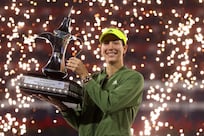Gerry Rafferty spent most of his life kicking against the fame that came with his authorship of the multimillion-selling hit Baker Street. For the three decades after its release in 1978, he shunned the spotlight to the point of becoming reclusive, all the time pulling in around £80,000 (Dh453,900) annually in royalties, much of which he drank away.
Born in Glasgow to a heavy-drinking Irish father who worked as a lorry driver, Rafferty learnt Irish and Scottish folks songs from his mother, who used to spirit her young son around town in the evenings to avoid the alcohol-induced rages of her husband.
As a teenager, heavily influenced by The Beatles and Bob Dylan, Rafferty started to write his own material. Teaching himself to play banjo, he busked on the London Underground for a period before returning to Scotland and a job as a clerk with the Department of Health and Social Security. In his spare time, he graduated from banjo onto bass guitar before stepping onstage with the Scottish comedian Billy Connolly in the latter's folk act, the Humblebums.
The group comprised Connolly, Rafferty and Tam Harvey. By its next incarnation, as The New Humblebums - also the new band's eponymous album - the trio had become a duo. But that too soon ended among rising tensions. Rafferty encouraged Connolly to pursue his career in comedy while he continued in the industry as a solo voice. With the Transatlantic label, he brought out his first album titled, Can I Have My Money Back? in 1971.
The following year, mindful of his new responsibilities as a father to a young daughter, Martha, he reunited with his school friend and early bandmate, Joe Egan, to form the group Stealers Wheel. Written in parody of Bob Dylan's tunes, their most famous song, Stuck in The Middle With You, mocked a music industry cocktail party, containing the lines, "Clowns to the left of me, jokers to the right, here I am, stuck in the middle with you." Many people confused it for a Bob Dylan song because of the intentional vocal similarity, with Rolling Stone magazine calling it "the best Dylan record since 1966". When Quentin Tarantino chose it as the accompanying track to the infamous ear-slicing scene in his 1992 film Reservoir Dogs, Rafferty accrued a whole new generation of listeners.
The band did not exhibit such staying power, however. "I was going through a very strange period in my life then," Rafferty told Rolling Stone in 1978. "I'd been living a dream for six or eight years and suddenly I woke up. It was a pretty scary kind of feeling. Perhaps I was on the edge of a nervous breakdown."
By 1975, after recording three albums, the group broke up. During the following three years Rafferty was embroiled in legal disputes before returning to a solo path. Signing with United Artists, in 1978 he released the album City to City, which included the track Baker Street, featuring an unforgettable saxophone riff. The single sold five million copies, debuting at number two in the UK chart, making Rafferty an overnight millionaire. But he was reluctant to tour in the wake of the single's success: touring, he said, involved "travelling everywhere" but "seeing nowhere".
He went on to record several more albums, but turned down various opportunities to collaborate with others in the industry, including Eric Clapton and Paul McCartney.
Instead, he lived in self-imposed exile on his 300-acre estate in Kent and slowly spiralled into alcoholism. Although he claimed that singing and writing were a far more effective antidote to the depression he experienced than Prozac, and claimed that songwriting was second nature to him, his final years were ignominious and the successes of his youth eluded him from the 1980s onwards. He was hailed as the industry's Lord Lucan after a disappearing act in 2008, but shrugged off the concerns of others and continued to move between his homes in Tuscany and England until ill health prevented him from travelling.
He married Carla Ventilla in 1970. The marriage was later dissolved. He is survived by their daughter Martha.
Born April 16, 1947; died January 4, 2011.
* The National









